FRUITS AND FRUIT-CULTURE. 97
FRUITS AND FRUIT-CULTURE.
Apples:
American Golden Pippin........... 99
Apple-Borer....................... 101
Apple-Worm....... ..............101
Baldwin............................ 99
Canker-Worm...................... 101
Caterpillar.......................... 101
Early Harvest...................... 99
Esopus Spitzenberg................ 99
Fall Pippin......................... 100
Gravenstein........................ 100
Hubbardston Nonsuch.............. 100
Insects, Destructive................ 101
Lady-Apple........................ 100
Maiden's Blush..................... 100
Off Years.... .................. ... 99
Picking and Keeping.............. 101
Red Astrachan ................... 100
Yellow Newtown Pippin........... 101
Budding.............................. 98
Cherries:
Bigarreau.......................... 110
Black Mazzard..................... 111
Black Tartarean....................111
Common Cherry.................... 110
Early Richmond.................... 111
Mayduke......................... 111
Pruning............................ 110
Soil.............................. 110
Cleft-grafting....................... 98
Crown-grafting...................... 98
Fastening............................. 98
General Remarks.................... 97
Grafting.............................. 97
Grapes:
American Grapes.................. 105
Black Hamburgh................... 105
Catawba............................ 105
Concord............................ 105
Grapes :
Cuttings........................... 107
Delaware........................... 105
Diana.............................. 105
Diseases............................ 108
European Grapes.................. 104
First Summer..................... 108
Fourth Season..................... 108
Fowls___.......................... 108
Grape-Culture..................... 107
Gray-rot............................ 108
Hartford Prolific................... 105
Hothouse Culture.................. 104
Iona................................ 105
Isabella............................. 107
Israella............................. 105
Martha............................. 105
Mildew........................... 108
Phylloxera......................... 108
Plants............................. 107
Pruning............................ 108
Rebecca............................ 107
Second Season..................... 108
Scuppernong....................... 107
Third Season...................... 108
To Keep in Winter................. 108
Trellises............................ 108
Wilder Grape..................... 105
Winter Treatment.................. 108
How to Graft........................ 98
Mulching............................ 97
Peaches:
Blood Clingstone................... 103
Cooledge‘s Favorite................ 103
Crawford‘s Late................... 104
Early Crawford.................... 104
Enemies............................ 104
Grosse Mignonne.................. 104
Morris White...................... 104
Peaches:
Soil and Exposure ................. 103
Various Hints...................... 103
Pears :
Bark-louse........................ 103
Bartlett............................ 101
Beurré Box........................ 101
Beurré Diel........................ 103
Blight............................ 103
Budding, or Grafting.............. 101
Diseases of Pears.................. 103
Flemish Beauty................... 103
Picking............................. 101
Rostiezer ......................... 103
Seckel.............................. 103
Soil and Planting.................. 101
Winter Nélis....................... 103
Peg-grafting......................... 98
Plums:
Curculio............................ 110
Diseases of Plums.................. 110
Egg-Plum ........................ 109
Frogmore Damson................. 109
Green gage........................ 109
Jefferson........................... 109
Pruning........................... 109
Purple Favorite.................... 109
Soil and Fertilizing................ 109
Weevil, Plum...................... 110
Wild Plums........................ 109
Quinces :
Angers............................. 110
Apple-shapes....................... 110
Japan ............................. 110
Portugal........................... 110
Saddle-grafting...................... 98
Scion and Stock...................... 99
Shoulder-grafting.................... 98
Tongue-grafting..................... 98
GENERAL REMARKS ON FRUIT-
GROWING.
The soil usually considered the best for grow
ing Apple, Pear, Cherry and Plum Trees is
strong loam, clayey rather than sandy. Fruits
which entirely fail from disease and the attacks
of insects, grown upon sandy soil, come to great
perfection upon clayey loam. In gardens where
the soil is not deep and rich, there should be
a trench made. This helps the roots to retain
their vigor through the dry summer weather.
Trees may be transplanted with success. If re
planting an orchard, do not plant in the same
places where the old trees stood. The size of
trees for transplanting varies with the kind of
tree and the object of the culture. But a rule
which is approved by the best authorities is, from
three to seven feet high. Never be in too great
a hurry to have an orchard bear. Transplanting
large trees may be sometimes accomplished with
success, but not often. When large trees are to
be moved, they should have a trench dug around
them far enough from the trunk to include a
mass of earth and roots, and the roots beyond
may be cut off, and the earth put back into the
trench. This should be done early in the spring
of the year preceding the removal. The result
will be a growth of young rootlets, which are
almost certain to insure for the tree a successful
start when put into its new bed. Do not plant
too deep; but leave the tree at the same level,
when transplanted, as before. Mulching after
transplanting is of service. This is simply sup
plying a covering of barnyard straw, which
helps retain the moisture. The best times
for transplanting are, early in autumn, and early
in spring. Of the two, the autumn is prefer
able, as the plants are then in a dormant state.
See that the ground is well prepared, so that
the trees may retain all the strength and good
qualities which originally belonged to them, and
easily assimilate more in their new position.
GRAFTING.
This is the uniting of a young scion or shoot
of one kind of plant to a stem or stock of another
kind, so that the scion may receive nourishment
from the stock. Grafting was largely practiced
in ancient times, and it now forms an important
part of the art of gardening. It is chiefly valu
able as it perpetuates and propagates the finest
98
THE FRIEND OF ALL.
varieties of fruit-trees and grape-vines, which
could not be successfully raised from the seed.
It is also of great use in hastening and increas
ing the fruitfulness of trees, the circulation of the
sap being impeded at the junction of the stock
and scion as by a deep wound, and by repeated
grafting gardeners often obtain fruit and flowers
much sooner than would naturally be the case.
Grafting is also employed to turn to account the
vigor of a root of which the branches are ex
hausted or otherwise unproductive, and large
crops of fruit may often thus be obtained in a
garden much sooner than by any other means.
How to Graft—In grafting, it is particularly to
be attended to that the alburnum, or sap-wood, of
the scion is brought into contact with that of the
stock. The hard wood of the one never unites
with that of the other, remaining separate and
marking the place of the operation even in the
oldest trees. For scions or grafts, pieces of
about 6 to 8 inches long are generally taken from
the shoots of the previous summer, with several
buds, but portions of shoots two years old are
sometimes successfully employed. The time for
grafting is in spring, as soon as the sap begins to
appear. The scion should, if possible, be taken
from a healthy and fruitful tree, but scions from
the extremities of lateral branches are more
likely to become speedily fruitful than those
from the uppermost branches, where growth is
most vigorous. The scion should be kept for a
few days before grafting, so that the stock may
rather exceed it, not only in vigor, but in the
progress of its spring growth ; and for this pur
pose may be placed in the ground, in a rather
dry soil, sheltered from the direct rays of the
sun. Scions may be kept for some time, and ea
sily carried to a distance, by sticking their lower
end into a potato. The end should always be
freshly cut off when the scion is to be used.
There are various modes of grafting.
Cleft-grafting is very commonly practiced when
the stock is considerably thicker than the scion.
The stock being cut over, is cleft down, and the
graft, cut into the shape of a wedge at its lower
end by a sharp thin knife, is inserted into the
cleft. This mode of grafting is particularly ap
plicable to branches of large trees, when the in
troduction of a new variety of fruit, or increased
fruitfulness, is sought.
Crown-grafting is used for still thicker stocks,
which are cut across, and then cleft down by two
clefts crossing one another at right angles, two
scions being inserted close to the bark in each
cleft; or no cleft at all is made, and any desired
number of scions obliquely cut away on one side
are simply inserted between the bark and wood
of the stock, the operation in this case being de-
ferred till the bark readily parts from the wood.
In this kind of grafting, a longitudinal slit in the
bark of the stock, opposite to each graft, is ad
vantageous.
Tongue-grafting is the mode most commonly
practiced for young trees in nurseries. For this,
it is necessary that the stock and the scion should
be of not very different thickness. A slit or a
very narrow angular incision is made in the cen
ter of the stock downwards, and a similar one in
the scion upwards, both having been first cut
obliquely, at corresponding angles, and the tongue
thus made in the scion being inserted into the
incision in the stock, they are fastened very
closely and thoroughly together.
In saddie grafting, the end of the stock is cut
into the form of a wedge, and the scion is affixed
to it, the base of the scion having been cut or
slit up for the purpose.
Shoulder-grafting, used chiefly for ornamental
trees, is performed by cutting obliquely and then
cutting across a small part at the top of the stock,
so as to form a shoulder, the scion being cut to
fit it.
Peg-grafting, not now much in use, is accom
plished by making the end of the scion into a
peg, and boring the top of the stock to receive
it.
Fastening.—Whichever of these modes of graft
ing is adopted, the graft must be fastened in its
place by tying, for which purpose a strand of
bast-matting is commonly used. The access of
air is further prevented by means of clay, which
has been worked up with a little chopped hay,
horse or cow dung and water, and which is
applied to the place of junction so as to form a
ball, tapering both upward and downward. In
France, a composition of 28 parts black pitch, 28
Burgundy pitch, 16 yellow wax, 14 tallow and 14
sifted ashes, is generally used instead of clay.
Gutta-percha, applied in a soft state, has also
been used, or even blotting-paper held fast by
strips of sticking-plaster. A good wax or clay
for grafting, is made of 3 parts of resin, 3 of bees
wax and 2 of tallow, applied with a brush
while warm, or cooled as a plaster and carefully
bound about the stem. The progress of the
buds shows the union of the graft and stock, but
it is not generally safe to remove the clay in less
than three months ; and the ligatures, although
then loosened, are allowed to remain for some
time longer. From some kinds of fruit-trees,
fruit is often obtained in the second year after
grafting.
Budding is in principle the same as grafting ;
and flute-grafting is a kind of budding in which a
ring of bark is used instead of a single bud, and
a stock of similar thickness having been cut
over, a ring of bark is removed, and the foreign
one substituted. This is commonly preformed
FRUITS AND FRUIT-CULTURE.
99
in spring, when the bark parts readily, and is one
of the surest modes of grafting.
Inarching, or grafting by approach, in which the
scion is not cut off from its parent stem until it is
united to the new stock, is practiced chiefly in the
case of some valuable shrubs,kept in pots, in which
success by the ordinary methods is very doubtful.
Action and Reaction of Scion and Stock.—An effect
is produced by the stock on the scion which it
nourishes analogous to that of a change of soil;
much of the vigor of a strong healthy stock is
also communicated to a scion taken even from
an aged tree. There is, moreover, in some de
gree, an influence of the elaborated sap descend
ing from the scion on the stock which supports
it. An important part of the practical skill of
the gardener or nurseryman consists in the se
lection of the proper kinds of stocks for different
species and varieties of fruit-trees. The stock
and scion, however, must not be of species ex
tremely dissimilar. No credit is due to the
statements of ancient authors about vines graft
ed on fig-trees, apples on planes, etc, the sem
blance of which can only have been brought about
by some delusive artifice; for all attempts at
grafting fail except among plants of the same
genus, or at least of the same natural family.
APPLES.
A selection of healthy trees should be made at
a good nursery. They should be planted in
rows. The distance between the rows varies
with the plan of cultivation. If grass or grain is
to be grown in the field, fifty feet is a safe dis
tance apart; but if the apple-orchard is the main
thought of the owner, twenty-eight or thirty
feet should be allowed. Fallow crops raised in
orchards greatly stimulate the growth of the
trees, while grass and grain are rather a draw
back. The soil about the trees should be kept
free and well mellowed. If there be any sign of
deterioration, the trees should have a top-dress
ing of manure. Trees must be treated gener
ously in the fertilizing, and they will amply repay
the grower for the extra expense. Apple-trees
require little pruning if they are carefully pruned
in March when they are young. All dead limbs
and any which crowd should be cut away. The
places where amputation has taken place should
be smoothed and covered with a little liquid
shellac prepared for the purpose.
Off Years.—The bearing of apples is every other
year. The trees usually exhaust themselves so
that they require a year in which to store up
strength again to produce fruit-buds. Trees
may be made to bear on each year by removing
half the fruit when small. The bearing year
may be changed if desired by picking off the
fruit-buds as soon as they are formed.
From the almost endless varieties of apples
used for the table, for cooking and for the
market, we select leading ones:
American Golden Pippin.—A variety not as univer
sally known as it should be, but superior and
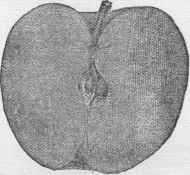
American Golden Pippin.
profitable. The fruit is of medium size, yellow,
dotted with gray or russet spots.
The Baldwin is a native of Massachusetts, where
it is largely raised. The tree is spreading and
productive. The fruit is large, round, yellow,
mostly covered with crimson stripes and orange,
has a few russet marks about the stalk. The
flesh is crispy and white, and the flavor high. The
apple is at its best in winter, though it may be
kept till spring.
The Early Harvest is one of the earliest and best
liked of American apples. It is ripe about the
fourth of July. The fruit is of medium size, of a
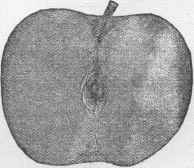
Early Harvest.
handsome straw-color with a few whitish dots,
The flesh is white and crispy, and the flavor
fine.
Esopus Spitzenberg.—This apple is a favorite
throughout New York State, where it originated,
and where it grows in great perfection. The
tree has long shoots and hanging branches. The
fruit is large, oblong, the color on one side is
yellow with streaks of red, while the whole is
red covered with yellowish-brown dots. The
stalk is long and slender. The flavor is very
100
THE FRIEND OF ALL.
fine, and the flesh firm and juicy. It is a good
winter apple.
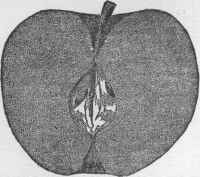
Esopus Spitzenberg.
Fall Pippin.—This is the first and best of autumn
apples in the Middle States. The tree is very
vigorous and spreading; the fruit large, round
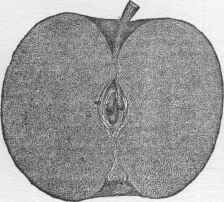
Fall Pippin.
and green, turning to yellow as it ripens. The flesh
is tender, mellow and white.
Graven stein.—This apple is of German origin,
but has attained a high place in this country.
It bears early, and is very productive. The fruit
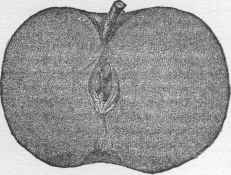
Gravenstein Apple.
is large and a little onesided. The skin is
greenish yellow, turning to bright yellow, mar
bled with red and orange. The flesh is tender,
crispy, high-flavored and slightly aromatic.
Hubbardston Nonsuch.—This is an early winter
apple, very large, irregularly striped with light
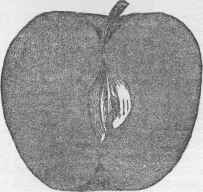
HUBBARDSTON NONSUCH.
and dark red on a yellow ground. Sweetness
and acidity are agreeably mingled in its flavor.
Lady-Apple.—A dainty apple for the table, and
a favorite with children, bringing a high price at
Christmastime. It is a French variety of which
there are a number, none of which are much

Lady-Apple.
grown here, except the lady-apple. The fruit is
very small but regular, a little flat in shape. The
skin is very glossy; it has a bright red cheek
upon a bright yellow ground. The flesh is crisp,
very white and tender, and the flavor good.
The Maiden's Blush is one of the early apples,
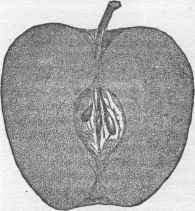
Red Astrachan.
and has much of the beauty of the lady-apple,
being therefore a great favorite for table use.
The Red Astrachan is probably a native of Swe
den, and is a fruit of great beauty. The fruit is
FRUITS AND FRUIT-CULTURE. 101
rather large, deep crimson, with a bit of green,
and it has a fine bloom.
Yellow Newtown Pippin.—This variety and the
Green Newtown Pippin are two fine varieties.
The yellow pippin is rather handsomer, but the
green is more juicy. They are both high-flavored,
and good in late winter.
Picking and Keeping Apples.—In order to secure
sound apples and have them keep well, they
should be picked by hand, and when dry. For
winter use, delay as long as the frost will allow
you, safely. Some hold that the best method of
preserving apples is to pack carefully in clean
barrels, leaving them unheaded for a while in a
cool, dry place, where they will not be frostbitten.
Others place the apples in open bins or on the
floor, where they can be kept until dampness has
disappeared, when they can be barreled and sent
away to market, or kept in a dry cellar. Cellars
in gravelly soil, and properly ventilated, are
generally excellent places for keeping fruit and
vegetables. Barrels should be laid upon their
sides.
INSECTS DESTRUCTIVE TO APPLE-
TREES.
The Apple-Borer.—This is a grub which enters
the tree at the surface of the ground, and rapidly
girdles and perforates the tender bark, soon kill
ing the tree. The best way to kill the borer
is to pick it out of the hole, or else force it far up
to the end of the hole.
The Caterpillar.—Caterpillars come in myriads
from eggs laid by moths the season before. They
spin and weave, making large nests which en
velop the leaves and branches, and all through
their seven weeks’ season they eat with voracity
the young leaves. The nests should be at once
removed. Never allow the caterpillars to make
headway. As they are lazy and do not leave the
nest before nine o‘clock, the observing and alert
gardener can annihilate them easily.
The Canker-Worm.—This pest has very nearly de
stroyed the apple-crop in New England the past
few years. Where the worms have been at work
the whole orchard looks as if fire had swept
through it.
They come out of the ground early in spring.
The females crawl slowly up the trunks, while
the males, being supplied with wings, can fly.
Eggs are laid in rows, and can be seen in
hundreds by the careful observer. These eggs
hatch in May, and the canker-worms immediately
begin their ravages, entirely destroying the foli
age of an orchard in a few days. To prevent the
inroads of the canker-worm, the common method
is to put around the trunks a piece of canvas
which has been tarred. Old India-rubber melted
makes a good adhesive substance, which will not
harden on exposure to the air. The female
worms are by this means kept from going up the
tree-trunks.
The Apple-Worm is a white grub found in apples
and pears, which usually drop before they are
ripe. A moth which appears in the warm even
ings of June, lays eggs in the blossom end of the
fruit. These eggs soon hatch, and the grub
makes its way into the fruit. When it leaves the
fruit it goes to the seams in the bark, and there
spins a cocoon from which, the next spring, the
moth comes. By keeping the bark clean and
carefully searching for the cocoon, the gardener
can keep free from this pest.
PEARS.
The pear-tree is not a native of America, but
has been brought here from Europe. It grows
wild in Europe and Asia, and reaches a great size
and age. Within two hundred years it has been
largely cultivated, and in the last fifty years Bel
gium and England have been producing choice
seedlings and crosses. In our own country new
seedlings are constantly appearing. The soil
and climate of the Middle States are well suited
to pear-growing, and very nearly coincide in
these respects with Belgium, where the fruit
reaches its greatest perfection. The wood is red
dish, very hard, fine-grained, and is often dyed
black in imitation of ebony, which it resembles.
Soil and Planting.—The soil best suited to pear-
trees is a strong loam, moderately deep. Too
moist a soil is unfit, as well as one too rich and
heavy. The trees should be planted, thirty feet
apart, in rows. They grow well in gardens, with
a little pruning. Pears require less pruning than
any other fruit. They may be raised from the
seed.
Budding or Grafting.—The budding in pear-grow-
ing is very successful, and should be done in
August. Seedlings of two years’ growth are in
suitable condition to be budded or grafted.
When grafted upon thorn-quince or mountain-
ash, the size is dwarfed, and the whole strength
goes into fruit-bearing.
Picking.—Pears should be picked before they
are ripe. The flavor is much finer if they ripen
indoors; indeed, some pears are mealy and
tasteless if left until ripe upon the trees.
Only a few of the thousand varieties will be
noticed here, and those the best for table and
market.
Bartlett.—This pear should have the first men
tion, for it is certainly the most popular. It is
far too well known to need description. It is
ripe the last of August.
Beurre Bosc.—A handsome pear. Fruit large
and pyriform, tapering to the stalk. Skin
102 THE FRIEND OF ALL.
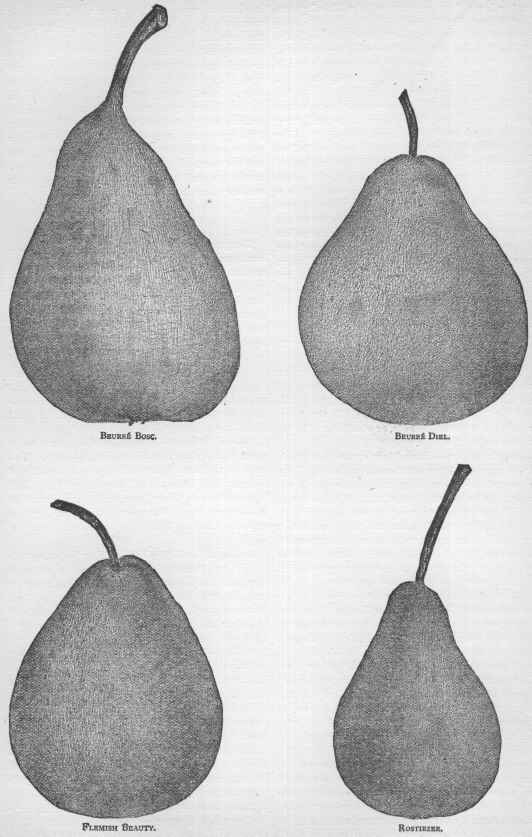
FRUITS AND FRUIT-CULTURE. 103
smooth, dark yellow dotted with russet, and one
cheek slightly red. Flesh white, buttery, melt
ing; the flavor rich.
Beurre Diel is a great favorite. The tree is very
vigorous. Fruit large ; skin thick; color from
lemon to orange, marbled with russet. Flesh
a little coarse, but rich and sweet. Good for
eating from September to December.
Flemish Beauty.—Fruit a handsome russet when
mature; surface rough and skin thick. The
flavor is very high, and the flesh juicy if picked
early and ripened indoors.
Rostiezer.—A foreign variety of superior qua
lity. The fruit is small; the flesh juicy, of pleas
ant perfume. Ripe by the 15th of August. One
of the very best pears.
Seckel. — This is an American pear, and is
placed by many pomologists at the head of the
list. The tree is very hardy, of good shape. The
fruit hangs in clusters at the ends of the
branches, and is small and red-brown, with a
spicy aroma and flavor. This pear is very juicy,
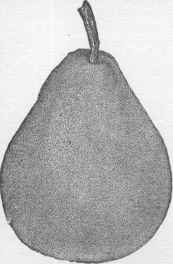
Seckel.
and brings a good price in the market. Ripe
from September 1st.
Winter Nelis.—This holds a high place as a win
ter pear. The fruit is medium-sized; skin yellow
ish green, with streaks of russet on one cheek.
Flesh fine-grained, juicy, a rich aromatic flavor.
Keeps well in the winter.
Diseases.—Of the enemies of the pear the
blight is the worst, destroying whole trees with
out warning. It is caused by a tiny fungus.
The diseased boughs must be cut away. The
bark-louse is destructive, but with an alkaline
mixture carefully used can be usually destroyed.
There are many insects destructive to the leaves.
The dusting of ashes, dry dust and quicklime
over the leaves is sometimes beneficial.
PEACHES.
There is no country in which peach-trees grow
and flourish so well as our own. In many sec
tions they grow finely, but in Delaware, Mary
land and Virginia, and the Lake Michigan
region they reach perfection. The fruit is
grown so easily and so rapidly, and the demand
is so large, that gardeners have become careless
and have neglected their orchards, and the past
two or three years very inferior fruit has been
offered in the Eastern market.
Soil and Exposure.—The soil which best suits
the peach is a mellow loam. In regions where
there is danger of spring frosts, the orchards
should be planted on northern exposures. In
southern aspects the blossoms get far advanced,
and the frost kills them. The Southern growers
enrich the soil with top-dressing and leave it,
while in the North the soil is worked and mel-
lowed much as in apple-orchards.
Various Hints.—Peach-stones planted in autumn
will shoot up the next spring and grow rapidly,
and in two years usually bear fruit. Gardeners
bury peach-stones, selected with care, in the
ground through the winter. In the early spring
these stones are taken up, and the kernels removed
and sown in well-prepared earth. Here they
grow, and are ready for budding in September.
Grafting is little used with the peach, as budding
can be easily done. Trees are in good condition
for transplanting one year from budding. The
trees should be set about twenty-eight feet apart.
An orchard bears regularly usually the third or
fourth year. Up to the first blossoming year do
not prune, but as fruit grows on the shoots of
the previous year‘s growth, it will be well for
these shoots in early spring to be cut back, at
least half of them, thereby halving the quan
tity of the crop, but greatly improving its quali
ty. Trees treated in this way remain symmetri
cal in shape, and never become deformed from
the load of overweighted boughs. In this
country the growing of wall-peaches is little
practiced, though it might be done by those who
live beyond the latitude where they do not flour
ish in orchards. Forcing-houses are used by a
limited number.
A few varieties of the peach are here noticed,
selected as the favorites, and including both cling
stone and freestone.
Blood Clingstone.—A large peach, much valued
for preserving. The skin is very downy and
dull red, while the flesh is deep red. It is a seed
ling which has been grown in America from the
French Sanguinole à Chair Adherente.
Coo/edge’s Favorite is much grown in New
England. It is a very hardy peach, handsome
and of high flavor.
104 THE FRIEND OF ALL.
Early Crawford.—This is a yellow-fleshed peach,
very early, and in great demand in market. The
fruit is large, yellow-skinned, with a rosy cheek.
Freestone.

Crawford’s Late.—-This is raised from the Melo-
coton, or Malacatune as it is usually called, and
is like the Early Crawford, its near relative, a
very superior peach. The fruit large, yellow,
with a handsome red cheek; high flavor, juicy.
Freestone.
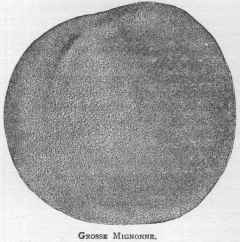
Grosse Mignonne.—This is a very popular peach,
taking place in the first rank. The fruit is large,
the skin of a pale yellow with red markings; and
of a high flavor. Freestone.
Morris White Rareripe is the most popular
white peach in market. The fruit is medium,
the skin covered with down and white, turning
to a delicate cream color when ripe; very juicy
and rich.
Enemies.—The Leaf-Curl is a comparatively in
significant disease, hurting the appearance of the
tree. The Yellows is probably fatal. The leaves
turn yellow, the fruit drops prematurely, and the
tree is apt to die. It is supposed to be the work
of a very minute fungus, and the only sure plan
is to cut down the affected tree, and prevent the
infection of others by it. The Peach-Borer is a
sad pest. A gum exudes where it has attacked.
Cut or dig it out. Severe cold is often fatal to
peach-trees.
GRAPES.
Grapes are usually divided into two large
classes, the European and the American. The
European grape shown in the cut is grown
in numberless varieties in different parts of the
world. In France, Italy and the Rhine country
grapes are grown with great success.
The growing of foreign grapes in our country
has been perseveringly tried, but it does not
succeed east of the Rocky Mountains except
under glass.
Hothouse Culture.—There are two methods of
raising grapes under glass, the first in a glass
house which is not artificially heated ; the other
is the hothouse, where by artificial heat fruit
may be forced for almost any season. As these
FRUITS AND FRUIT-CULTURE. 105
methods of raising are expensive and require much
care we have not treated of them in this article.
Neither have we spoken at length of the foreign-
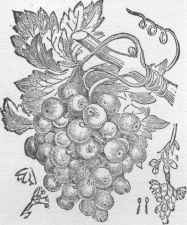
Vine (Vitis vinifera), showing the flowers and their parts
the leaves, and the fruit.
grape vineyards in California, which with the
wine-making constitute there such an important
industry.
American Grapes.—Along the Pacific coast the
different varieties flourish well, and the yearly
increasing vineyards prove the profitable growth
of the vine. Of the American grapes there are
usually reckoned four kinds : the northern or fox-
grape, the summer grape, the frost grape, and
the muscadine or southern grape. A few years
ago there were only two cultivated varieties, the
Catawba and Isabella. Now the number is great,
and new varieties are every year brought forward
by enterprising gardeners. Perhaps the most
popular kinds with us are Concord, Catawba,
Iona, Delaware and Norton's Virginia. This
last-named, is however, only grown for wine,
while the others find a ready market, where they
bring much higher prices than for the purpose
of wine-making.
A few words about some of the different varie
ties and their growth will be here given.
The Concord.—This is so well known that no
description need be given. It has been raised in
large quantities, but within the last few years it
has rotted badly, and is not therefore considered
reliable. It grows rapidly and will bear neglect.
A wine of fair quality can be made from it with
the use of a little artificial heat.
Catawba.—This grape is still a very great favor
ite, although, except in certain localities, it is
very unreliable. The flavor is high, and the wine
made from it fine. In the New York lake
region the Catawba grows well.
Martha.—This is one of the best white grapes
raised. It succeeds well in different States,
being even hardier than the Concord, of which it
is a seedling. The bunches are medium-sized ;
berry a trifle smaller than the Concord, and has
a white bloom. The pulp is soft and sweet,
and if not too ripe, juicy, An excellent wine is
made from it.
Wilder (Rogers’ No. 4).—This is a grape good
for the table and for wine. The vine is a
healthy grower, and needs to have the fruit
thinned out, as it bears abundantly. The
bunches are large and heavy; the berries round
and black, with a fine blue bloom. It ripens
earlier than the Concord.
Diana is a seedling of the Catawba. This
grape should be fully ripened before being
picked. It is an abundant grower, and requires
pruning, but not very rich soil. The bunches
are large, compact, and have often a little bunch
attached. The color is a lilac-red. The fruit
ripens late, and will keep well during the winter.
Delaware.—This requires a rich, well-drained
soil. It is very productive where it grows suc
cessfully, but it is rather delicate, and only suc
ceeds in certain localities. The clusters are
small but compact, and generally shouldered.
The berry is small, red, and has a beautiful
bloom upon it. It is high-flavored and sweet.
Hartford Prolific.—This, as its name indicates,
is productive and hardy. It has large bunches.
The berries are large and black, with a bloom,
and have a perfume like wild grapes. The
grapes ripen early, but drop from the bunch
when fully ripe, and are therefore troublesome
to market.
lona.— This favorite, grown largely in New
York State, was originated by Dr. C. W. Grant,
then at Iona Island, in the Hudson, a little
above Peekskill, but across the river. It pro
duces a bunch of good size, shouldered, often
double-shouldered. The berries are light red,
with fine bloom ; skin thin, and the flesh, ten
der, sweet and very juicy. It ripens about the
time of the Delaware.
Black Hamburgh.—This has long held the first
place among black grapes for the vinery, but
will rarely perfect its fruit out-of-doors. Its
large size and luscious flavor have won and kept
for it universal esteem. The bunches are large
(about nine inches deep), and mostly with two
shoulders, making it broad at the top. The ber-
ries are large, roundish and slightly inclining to
oval. The skin is thickish, deep brownish pur
ple, becoming nearly black when quite ripe, with
a very sugary and rich flavor. A good and re
gular bearer.
Israella.—This grape originated as did the Iona,
with Dr. C. W. Grant, of Iona Island. It is vig
orous, hardy and productive. The bunches are
medium to large, shouldered and compact,
106 THE FRIEND OF ALL.
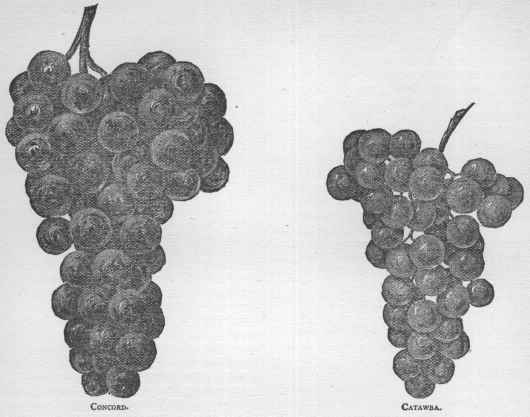
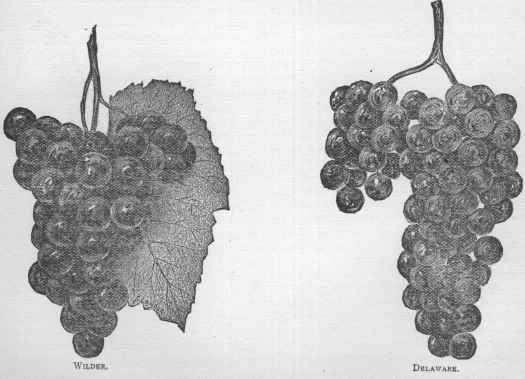
FRUITS AND FRUIT-CULTURE.
107
The berries are large and slightly oval, with
rather thin skin, and flesh tender, juicy, free
from pulp and sweet. Ripens soon after Hart
ford Prolific.
Rebecca.—Originated in the garden of E. M.
Peake, Esq., Hudson, N. Y. Vine moderately
vigorous, a nice amateur grape, and succeeds
well in certain localities. The bunches are me
dium, compact, rarely shouldered, with berries of
full medium size, roundish oval, adhering strongly
to the stem. Color auburn or golden in the sun
and light green in the shade, covered with a
light bloom. Flesh firm, juicy, sweet and deli
cious. Ripens with Isabella, and keeps well.
Isabella.—This grape, native of South Carolina,
was brought north and introduced about 1818.
Its great vigor, hardiness and productiveness,
with little care, have given it a wide dissemina
tion. Bunches of good size, five to seven inches
long, rather loose, shouldered, with berries oval
and quite large. Skin thick, dark purple, be
coming at last nearly black, with a blue bloom.
The flesh is tender, with some pulp, which nearly
dissolves when fully mature; juicy, sweet, and
rich, with slight musky aroma. This grape is
frequently picked as soon as well colored, and
long before it is ripe.
Scuppernong.—This is a very distinct Southern
species, growing wild from Virginia to Florida,
and climbing to the tops of the tallest trees.
Unlike other grapes, its leaves are small, seldom
over two or three inches in diameter, glossy and
smooth on each surface. It is too tender for the
Northern climate, being killed to the ground in
our winters. At the South it is hardy, produc
tive, and an excellent wine grape. The White
and Black Scuppernong are hardly different ex
cept in colors, to which also the tendrils of each
correspond. The bunches are small, loose, sel
dom composed of more than six berries, which
are round and large, with skin thick, light green
in the white, dark red in the black variety. Flesh
quite pulpy, except when thoroughly ripe, juicy
and sweet, but with a strong musky scent and
flavor.
GRAPE CULTURE.
Cuttings.-Grapes may be raised either from
the seeds or from cuttings and plants. The
last-named method is much the best. In the
autumn cuttings should be made from the old
wood, and carefully put away until spring, either
in a cellar or buried in the ground. In the spring
the cuttings should be planted in a light sandy
soil with a southern exposure. They should be
planted so as to cover all the buds but one. The
growth of the summer should be pruned in the
autumn, leaving two branches, and those cut
down to four joints. The next year two main
branches may be allowed to spring up, but the
numberless side-shoots should be pinched off;
and in the autumn again prune the vine as far
as the eighth joint. After the second year, the
only pruning needed will be that which tends to
increase the fruit.
Plants.—The safest method is, however, to
raise from the young plants, as the best growing

cuttings are not likely to have an even growth.
Plants one year old, either from cuttings, layers
or single eyes bought of a reliable nurseryman,
are almost sure, with favorable location and soil,
to do well. The plants should have strong well-
ripened roots in abundance, also short-jointed
wood well ripened. Some cultivators prefer fall
planting. The ground should be marked off at
suitable distances, and holes 8 or 10 inches deep
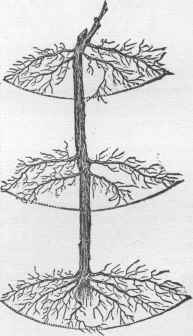
YOUNG VINE READY TO PLANT.
should be dug in a slanting direction. The
figure shows the plant ready to be put in the
ground.
Having laid the plant in and carefully fixed
the roots, fill up the hole with firm earth, leav
ing the top bud just above the ground. In fall
planting dig a ridge about each vine, that the
108 THE FRIEND OF ALL.
water may drain off. There should also be a
little mulch put about the vine as a protection.
Never attempt planting unless the weather be
dry and the ground mellow.
For the First Summer there is nothing neces
sary but to keep the soil stirred well about the
vines. If the plants are very vigorous, they
should be tied to stakes. As the shoots appear
they must be rubbed off, keeping only one shoot,
which should have all the side or lateral shoots
allowed to grow. When autumn comes, cut back
the vine to two or three buds.
In the Winter, Trellises should be made, as they
will be needed in the spring. Posts of cedar are
excellent; they should be about six or eight feet
long. Char the lower ends, then bore holes for
either a three-or-two wire trellis. The holes for
the posts should be dug two feet deep, and the
posts should be well set. Wire size No. 12 will
make a strong support. The trellises should
have a brace, which can be seen below, show
ing a vine pruned and tied, at the end of the
Second Summer. This method has been tried
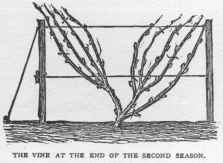
with great success by some of the most enter
prising grape-growers in the country. In the
autumn of the second year, the vines should be
trimmed as soon as the leaves drop.
The Third Season, at its beginning, should see
the vines plowed and hoed, and the soil well
stirred. When the shoots are young, the thumb-
and-finger pruning—which is difficult for amateurs
to learn, as it is the fine art of pruning—must be
begun. The early pinching of the shoots throws
the strength of the vine into developing the
bunches and leaves upon the shoot which re
mains. The bunches and leaves develop much
more rapidly in consequence. If the pinching be
left until after the blossoming the shoots will
have become quite hard, and the plant does not
thrive as well when the knife has to be used so
freely. After the blooming, the laterals will
start upon the bearing shoots. These should
be pinched off to one or two leaves, and the
leaf, as it quickly grows, serves as a conductor
of sap to the bunch opposite, and also as a
protection from storm and sun. The stalks
from the spurs, two or so having been left from
the first pinching, as they have now grown to
the length of three feet, should be pinched.
These are designed as the stalks for bearing the
following season, and this pinching will increase
the growth of the lateral shoots. The young
stalks should be tied firmly, though carefully,
along the upper wire. Sometimes a fruit-branch
will need a little help in holding its load, and
may be tied; usually it may be allowed to hang.
The object of the fall Pruning and summer
pruning is identical: to keep the vine within
proper limits, to save its strength for bearing
fine fruit, and for the growth of wood for the fol
lowing year. Practice is required to know just
how to treat different vines at different times,
but careful observations on the nature and
habits of vines will greatly assist the grower.
For the Fourth Season the care is much the
same as for the third. A lack of vigorous
growth in a vine shows that some compost, bone-
ashes or woods-soil, may be needed as a tonic.
Pruning in the fall is best, but can be done as
late as March. Remember that sound cuttings of
the last season‘s growth may be sold, and will, if
from choice varieties, largely add to the profits
of the vineyard.
Diseases of Grape-Vines.—Mildew is perhaps the
worst. This is disastrous with the Catawba,
but seldom attacks the Concord or the Martha.
Close early pruning helps to prevent this fungus
from destroying the crop. Sulphur dusted on
the leaves and fruit will aid in destroying mildew.
Phylloxera, or Root-louse, is a very great pest,
attacking varieties which tend to root near the
surface. There is the gray-rot and spotted, or
brown-rot, which occasionally is very destructive.
The best plan for avoiding these diseases is to
try new varieties which will flourish in the
same places where the old vines have become
diseased.
There are some small insects which occasional
ly attack and prey upon the young shoots. But
they can be easily kept down by syringing the
parts affected with a solution of whale-oil soap.
Turkeys, ducks, and hens are most helpful in re
moving the multitude of insects which infest
the vines, but must be kept out of the way of
the ripening fruit.
To Keep in Winter.—Grapes may be preserved
well into the winter, by observing the rule here
given. Cut the bunches on a warm day, and lay
them in a cool place for a few days. Pack the
bunches in paper boxes, taking care to remove
all imperfect grapes. In the bottom of each
box put a layer of newspaper, then a layer of fruit,
and so on until there are three layers in the
boxes, not more. The boxes must be put in a
dry room which is not very cold,
FRUITS AND FRUIT-CULTURE.
109
PLUMS.
There are three kinds of wild plum in this
country, the beach plum, the red and yellow
plum, and the Chickasaw plum. These are
seldom if ever cultivated, but the ancestor of
our fine kinds is a native of Asia and Southern
Europe. The soil and climate of the Middle
States are well adapted to plum-culture. The
plum is certainly a very delicious fruit, but for
table use it is not in such great demand as the
other fruits. For cooking, canning, preserving,
it is the most prized, perhaps, of all. The busi
ness of growing plums for prunes is one very
important in France. A few choice varieties
are raised with care, and being dried and pre
pared in certain ways are known as German
prunes, St. Catharine Brignolles, etc.
Soil, and Fertilizing.—The plum flourishes on a
heavy soil with a mixture of clay. Salt is con
sidered good, and swamp muck, especially that
from salt-water marshes, is beneficial as a ferti
lizer. The plum grows readily from seeds.
Stones planted as soon as they are gathered will
reach a height of two feet the following year.
The next spring they will be suitable for planting
in nursery-beds, and should under ordinary con
ditions be ready for working the following
summer. The plum does not bud easily, so
much care is required to successfully accom
plish it.
Plum-trees need little Pruning besides thin
ning overcrowded trees, and old trees may be
made more vigorous by “heading them in,”
carefully covering the wounds with shellac, and
giving the roots a top-dressing.
Green Gage.—This stands first in popularity.
The fruit is round and rather small; skin yel-
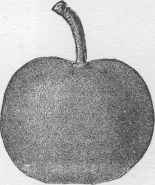
Green Gage.
lowish green; flesh pale green; flavor good.
Ripe in August.
Frogmore Damson.—Fruit a little larger than av
erage, purplish black, inclining to obtuse oval in
shape; flesh tender, and richly flavored. An
English plum, and an enormous bearer.
Jefferson.—This is a handsome plum for the
table, and something of the order of the green
gage, only much larger. The skin is yellow, often
with a purple-red cheek; flesh an orange color,
and high-flavored.
Purple Favorite.—This plum, when grown in per
fection, stands in the very front rank. It is much
finer than the purple gage, and grows well in the
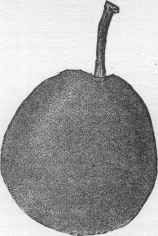
Purple Favorite.
garden. The fruit is medium-sized, the skin is
covered with a delicate blue bloom, and the color
is brownish purple. The flesh is green and melt
ing, juicy and sweet. Parts freely from the stone,
which is small and roundish.
The Egg-Plum is widely known, though under
unfavorable conditions it has not much to recom-
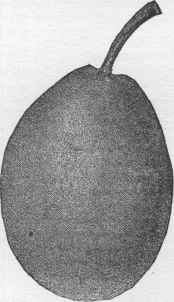
Egg-Plum.
mend it for the table, but is excellent for cook
ing. With warm location and when left to fully
110 THE FRIEND OF ALL.
mature it is good flavored. Fruit very large;
skin yellow and dotted. Ripe in August.
Diseases.—The Black Wart is very destructive
to plum-trees. This is now considered due to a
fungus, and all boughs affected should be de
stroyed. A beetle called the plum-weevil, or cur-
culio, lays its eggs in the fruit, and these eggs pro
duce a grub which feeds upon the fruit. The fruit
soon drops to the ground, where the grub can get
into the earth. By spreading down sheets and
tapping the tree with a wooden hammer, many
beetles are shaken off and can be easily killed.
This several times repeated will destroy great
numbers. Of course all the fallen plums should be
gathered at once, or new beetles will be pro
duced.
QUINCES.
The quince tree or bush is well known on both
continents. The tree grows seldom with us
higher than a bush. The blossoms are large
pink and white.
The quince is unfit for eating raw, but it is in
great demand for preserving. The flavor is very
high even when dried. There are two kinds of
quince much grown, the apple and pear-quince;
the former early.
The quince requires a moist soil, well manured
and will bear large fruit if so grown. Little or no
pruning is required. It may be grown from seed,
cuttings, or be budded. The stocks of the
quince are much used for grafting or budding
the pear.
Apple-shaped Quince.—The most popular variety
in the country, bears large roundish, apple-shaped
fruit, which stews quite tender, and is of excel
lent flavor. It bears most abundant crops.
Leaves oval. Fruit size of a large apple, fair and
smooth, and a fine golden color.
Angers.—This variety is generally used for pear
stocks. It is a thrifty grower, and an abundant
bearer. Much like the Apple, not quite so ten
der, a little more acid, and will keep longer.
Portugal Quince.—Rather superior to all others
in quality, as it is less harsh, stews much better,
and is altogether of a milder flavor, though not
fit for eating raw. The flesh turns a fine purple
or deep crimson when cooked. The leaf is larger
than that of the usual quince, and the growth
of the tree stronger. Fruit of the largest size,
oblong ovate, obtuse. It is unfortunately a shy
bearer.
Japan Quince.—This is a low thorny shrub, with
small dark green leaves. In April its branches
bear numerous clusters of blossoms shaped like
those of the quince, but a little larger and of the
brightest scarlet. Fruit dark green, very hard,
and useless; and the only redemption of the plant
is, that in blossoming time it becomes the most
brilliant object in the shrubbery.
CHERRIES.
The cherry holds a high rank among fruits.
The tree grows rapidly, except the sour or red
cherry, and forms a handsome spreading tree
with smooth light bark. Cherry-wood is in great
demand for cabinet-making. In spring the
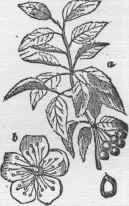
Common Cherry (Cerasus duracina): a, branchlet with leaves
and fruit; b, flower.
clusters of white blossoms are very beautiful,
and these blooms are followed by the fruit
which hangs gracefully from long stalks. The
cultivated cherry-seeds were brought to out
country in the early colonial days.
A so/7 that is dry is best suited to the cherry,
but as it is very hardy it will thrive in many
different locations. The usual method of grow
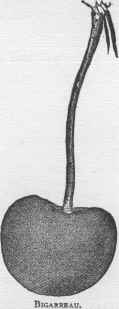
ing cherries is from buds which are propagated
on the black mazzard, which is a common variety.
Cherries are grown as standards very generally
in our country.
FRUITS AND FRUIT-CULTURE. 1ll
There should be but little pruning, and that
little should be done in midsummer. The pe
culiar gum which exudes is very similar to gum-
arabic, but it is a sort of decay which takes from
the strength of the tree.
Black Mazzard.—This is a common wild cherry
beautiful of the cherries. The tree is very hardy,
the fruit large and waxen in appearance, and
heart-shaped. As the cherry matures, the deli
cate dots deepen into bright red on one cheek.
The fruit is ripe the last of June.
Early Richmond, or Kentish.—This is an acid cher-
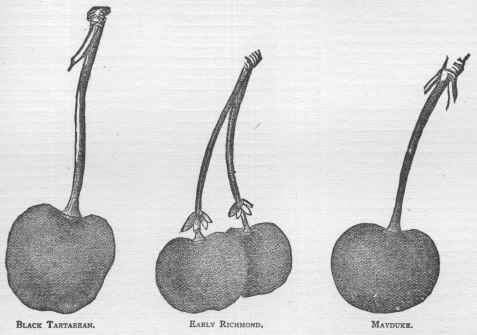
now naturalized here, of value as the stock of the
Heart varieties. The fruit is small and bitter
unless dead ripe.
Black Tartarean.—This is an early kind of very
superior quality. The tree grows rapidly, and is
vigorous. The fruit is large, heart-shaped, and
of a glossy black. The flesh is deliciously rich.
Bigarreau.—This is one of the most reliable and
ry, of great value for cooking. The skin is very
bright red. The fruit grows in pairs.
Mayduke.—This is a most popular early cherry,
thriving in all climates. Sometimes some of the
branches have clusters which ripen later than
others, and so the season is very long. The
fruit is round, heart-shaped; the color bright-red,
which grows dark when fully ripe.

But first, if you want to come back to this web site again, just add it to your bookmarks or favorites now! Then you'll find it easy!
Also, please consider sharing our helpful website with your online friends.
BELOW ARE OUR OTHER HEALTH WEB SITES: |
Copyright © 2000-present Donald Urquhart. All Rights Reserved. All universal rights reserved. Designated trademarks and brands are the property of their respective owners. Use of this Web site constitutes acceptance of our legal disclaimer. | Contact Us | Privacy Policy | About Us |